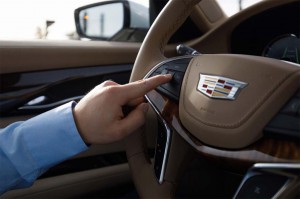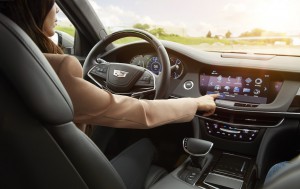Cadillac plans to expand the rollout of Super Cruise from just the 2018 CT6 to the brand’s entire line-up by 2020.
Super Cruise is the brand’s hands-free driver assistance technology. Executive Vice President Mark Reuss made the announcement during Detroit-area event. He added that after 2020, the technology will be made available on other products within the General Motors family.
Cadillac also plans to offer V2X communications in a high-volume crossover by 2023 and eventually expand the technology across Cadillac’s portfolio.
“The expansion of Super Cruise and V2X communications technology demonstrates Cadillac’s commitment to innovation, and to making customers’ lives better,” Reuss said. “GM is just as committed to ushering in a new era of personal transportation, and technologies like these will enable it.”
(Jaguar Land Rover aiming for off-road autonomy. Click Here for the story.)

A tap of the button turns Super Cruise on. But a camera on the wheel also makes sure the motorist is alert and ready to retake control.
The announcement comes as Tesla’s Autopilot is mired into controversy. Several Tesla vehicles have crashed while the technology was in use. The company in each instance has suggested driver error, not the semi-autonomous tech, was the cause. The National Traffic Safety Board is investigating to Tesla collisions now.
Conversely, Waymo just affirmed it placed an order for 62,000 Chrysler Pacifica Hybrid minivans to expand their self-driving passenger service in Arizona and other states. SuperCruise isn’t GM’s only stab at self-driving technology.
The company acquired Cruise Automation a few years ago for $1 billion to accelerate its development of driverless technology. The company is currently testing a fleet of autonomous Chevrolet Bolts. The progress made was substantive enough to entice Japanese investment firm SoftBank to invest an additional $2.25 billion in GM Cruise to ensure it meets its goal of having a fully autonomous vehicle ready by 2019.
GM CEO Mary Barra’s pledged at the 2014 ITS World Congress that Cadillac would begin offering advanced intelligent and connected technology in its vehicles.
(Click Here for more about SoftBank’s $2.25 billion investment in GM Cruise.)

Cadillac's Super Cruise semi-autonomous system is now available with an eye toward making it fully self-driving in the future.
“Cadillac is proud to be the leader for the company’s innovation,” said Steve Carlisle, Cadillac president. “Groundbreaking technologies like these continue to provide unparalleled comfort and convenience for our customers.”
Super Cruise is a driver assistance feature that uses “precision LiDAR map data, high precision GPS, a state-of-the-art driver attention system and a network of camera and radar sensors.” Designed primarily for use on freeways, uses must have an active OnStar service plan with emergency services to function.
The driver attention system helps to keep drivers engaged and detects when drivers need to pay more attention to the road. Even while using Super Cruise, drivers must always pay attention and not use a handheld device.
Cadillac introduced vehicle-to-vehicle (V2V) communications on the CTS sedan in 2017, which uses Dedicated Short-Range Communications (DSRC) technology. Using the Basic Safety Message as a base, V2V can be extended to the roadway infrastructure and other roadway users (e.g., cyclists, pedestrians, etc.) establishing a V2X ecosystem.
(To see more about 74% of Americans being “too afraid” to ride in self-driving vehicles, Click Here.)
Using V2X, compatible vehicles can be notified of hazardous road conditions, traffic light statuses, changing work zones and more. With a range of nearly 1,000 feet, drivers can be alerted to possible threats in time to avoid a crash.


Reuss was proud to demonstrate Super Cruise at the 2018 Detroit Grand Prix.